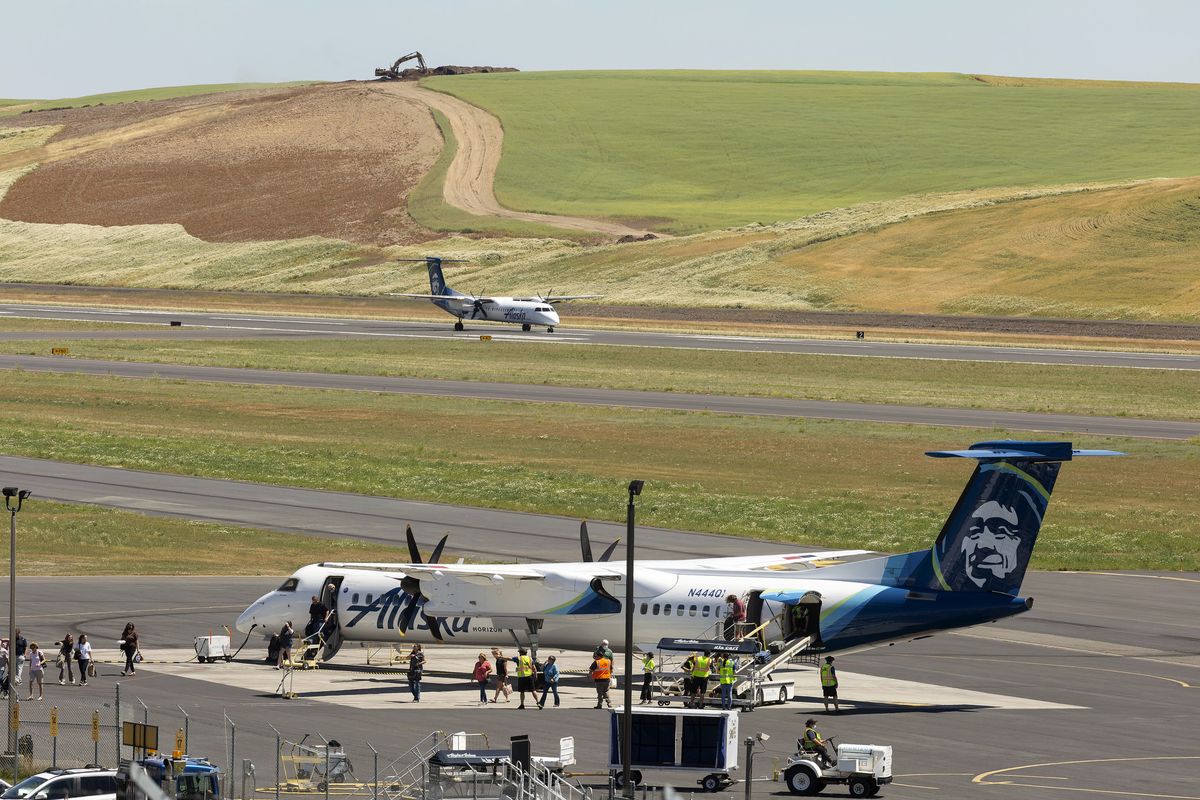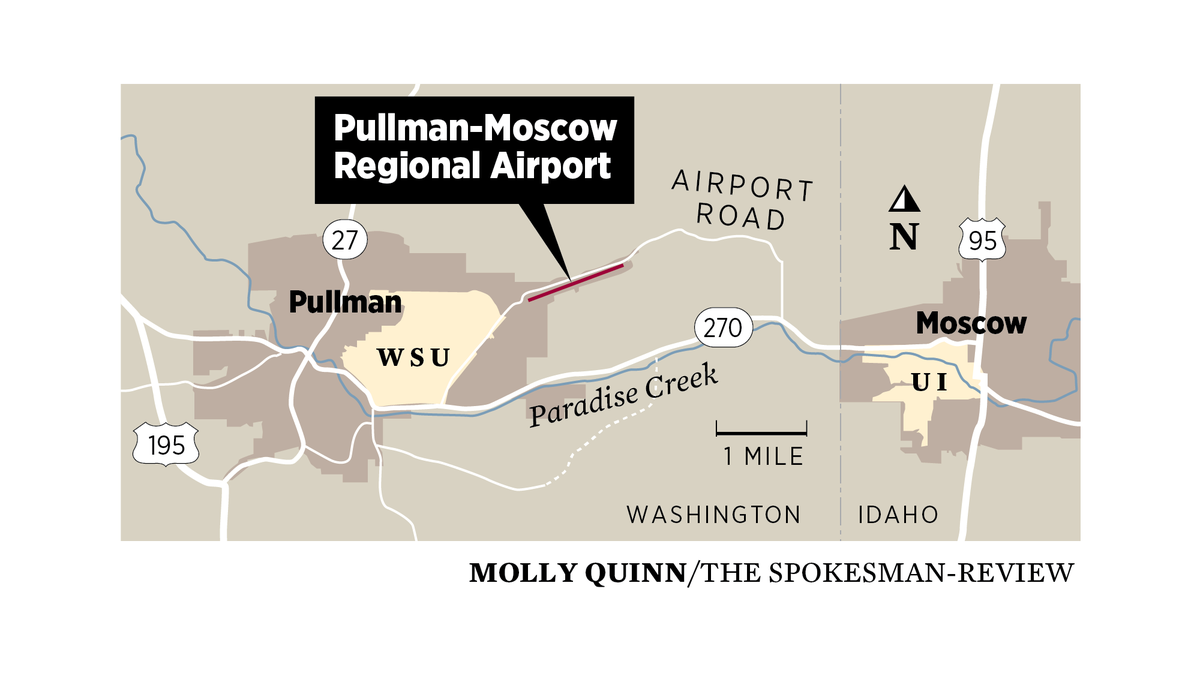Getting There: Pullman-Moscow Regional Airport’s new terminal will be five times bigger
Passengers exit an Alaska Air airplane Thursday outside the terminal at the Pullman-Moscow Regional Airport while another flight takes off from the new runway. (Geoff Crimmins/For The Spokesman-Review)Buy a print of this photo
With Pullman about to get an airport terminal five times as big as the existing one, officials hope more residents in the Palouse will choose to fly closer to home.
As finishing touches wrap up on a seven-year, $158 million runway realignment project, construction will begin next month on Pullman-Moscow Regional Airport’s new $81 million terminal.
The improvements will bring the airport into compliance with standards for handling larger aircraft and passenger volume.
The new terminal will be located at the northwest end of the airport and is expected to be finished by the end of 2023. It will replace the old 8,785 -square-foot terminal built in 1989.
The new building will start at 43,000 square feet with room to expand. With current passenger volume, the terminal should be closer to 50,000, said the airport’s executive director, Tony Bean .
The total of passengers flying in and out of the airport increased from about 30,100 in 2009 to about 70,500 in 2019, the year before the pandemic impacted air travel. Alaska Airlines currently offers three flights a day to Seattle and five flights a week to Boise. As a comparison, nearly 1,944,400 flew into and out of Spokane International Airport in 2019.
The old terminal could be used as a cargo facility, charter facility or for some other aviation use, Bean said, “but we can’t do a lot with the existing building because it’s not expandable; the parking lot is maxed out.”
The new parking lot will be three times bigger, with more room for rental cars.
Inside, the new terminal will have room for two Transportation Security Administration screening lanes, concession spaces on both sides of security, offices for rental cars and airlines, and a baggage claim with a carousel. The building will be on two levels, with passengers using the upper floor while the lower floor on the runway level will be used for baggage handling. This way, passengers will stay on the same level.
There will be three boarding gates, plus an extra gate that can be used for charter flights. One gate will have a boarding bridge, while the others will use ground boarding. More bridges may be added later. Currently passengers load and unload from the ground only.
“We are trying very hard to be as forward-thinking about this as possible, because we’ve seen what happens when you get behind it,” Bean said.
The estimated $81 million cost includes not only the building, but the aircraft parking apron, the parking lot and all the engineering costs.
“The building is probably the cheaper portion of it, because a lot of it is the infrastructure that needs to go in first,” Bean said.
The new terminal is related to a much larger project of realigning and expanding the runway that began in 2015.
The old runway was not in compliance with newer Bombardier Q400 turboprop aircraft, which require a greater distance between the runway centerline to the taxiway centerline, per Federal Aviation Administration standards. The taxiway had to be completely cleared before a larger plane could land. Now, aircraft can wait on the taxiway while others land or take off, which makes operations much smoother.
The runway was moved slightly and rotated 5.5 degrees counterclockwise to have better clearance with surrounding terrain. “We basically built an entire new airport on top of the airport that was existing,” Bean said.
The airport remained operational throughout the project except for one month when they switched from the old runway to the new. The new runway has been functional since 2019, although minor work on it has continued until now.
The runway was expanded from 6,700 feet to 7,100 feet in length, and from 100 feet to 150 in width. It is now capable of handling Boeing 737 jets, which universities charter for athletic teams.
The major project involved several land acquisitions, moving utilities and almost 9 million cubic yards of earthwork.
The airport also used the opportunity to install a landing instrument system to improve landings in low-visibility weather.
“One of the issues that had really plagued Pullman-Moscow was reliability,” Bean said. “We just didn’t have the capability with instrumentation and the lighting to land aircraft unless the weather was significantly higher than at other airports similar to ours.”
The airport’s cancellation rate for visibility has improved from an average of 90 a year to about eight, he said. “We still have cancellations, everyone has weather, but they are significantly lower than anything we experienced prior to the new runway.”
The projects have been partly funded with contributions from the cities of Pullman and Moscow, and Latah and Whitman counties, Washington State University and the University of Idaho, and the states of Idaho and Washington, as well as through grants and even private donors.
Schweitzer Engineering Laboratories donated $1 million toward the runway, with founder Ed Schweitzer matching another $1 million.
This year the FAA awarded the airport $17 million in grants for the new terminal and $11 million for the first phase of the new terminal apron.
With all the updates, there is greater potential for expanding commercial flights to more cities.
According to a 2019 year-end passenger demand analysis by Mead and Hunt, the engineering firm that oversaw both projects, 32% of area travelers used Pullman-Moscow, while 54% diverted to Spokane International Airport and 14% to other airports.
While flights from Pullman are only slightly more expensive than the same flights from Spokane, Spokane has many more options for travelers whose final destinations are beyond Seattle or Boise.
“We’re never going to be the size of Spokane, but we are close, convenient and connected,” Bean said. He does not view Spokane as competition, since his goal is to serve the communities that own the airport.
“We have a duty to the people that pay the taxes that own this infrastructure. And that’s one nice thing about airports. Airports are the only piece of really major transportation infrastructure that a small community can own.”
There are efforts to expand services, though. Direct flights to Boise resumed last August after years without service. The Idaho State Board of Education and the University of Idaho subsidizes flights to the Idaho capital to encourage enrollment at the University of Idaho in Moscow. The university is one year in to a three-year contract with Alaska Airlines.
“I’ve had a chance to fly that flight and it’s great,” Pullman mayor and chair of the airport board Glen Johnson said. “It’s a direct flight, plus you can make connections in Boise so you don’t have to go through Sea-Tac.”
The new facilities could accommodate multiple airlines. The airport has a grant from the U.S. Department of Transportation to help establish more routes. There have been conversations with United Airlines to start a flight to Denver, but they are on hold because of personnel and pilot shortages, Johnson said.

